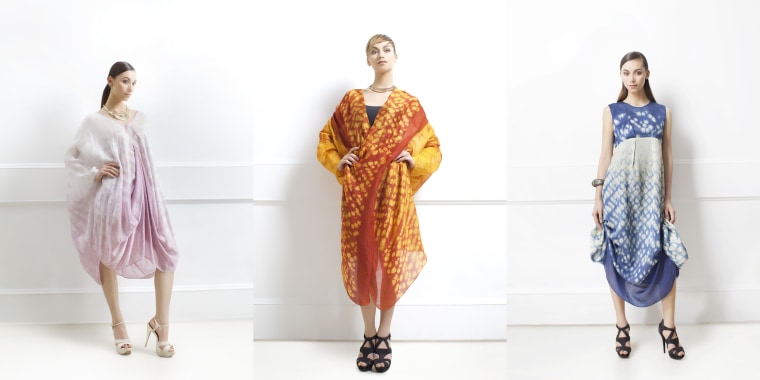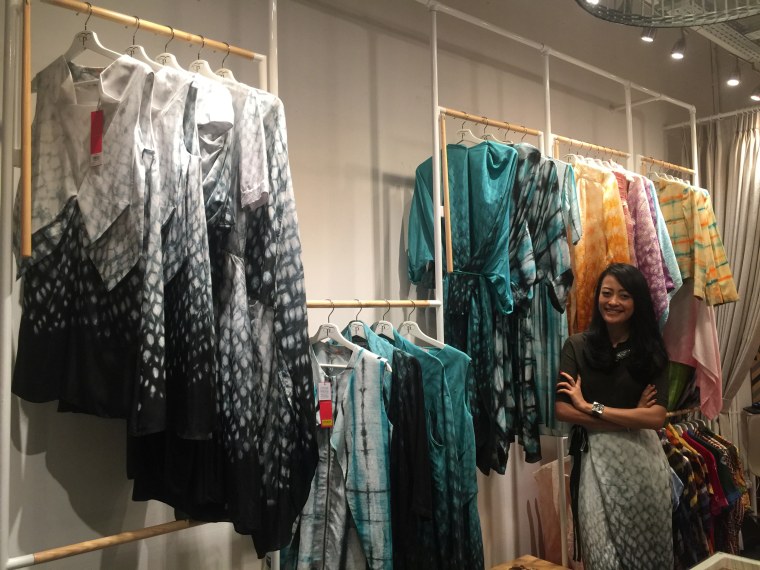JAKARTA, Indonesia — As a child, Nonita Respati thought she’d grow up and go into a profession with a fancy title: doctor, economist, maybe political scientist.
Fashion designer didn’t seem like a legitimate career choice. But that was over two decades ago, and now Respati is among a crop of fashion designers in Indonesia’s capital city of Jakarta who are giving the traditional batik a contemporary makeover.
Brightly hued and detailed, batik is the traditional fabric of the Southeast Asian country. Using hot wax to block out a specific area of the fabric before dying, batik designs can be deeply symbolic.
“If you see batik 20 or 30 years ago and batik now, it’s a totally different story because 20 or 30 years ago you would only see it as ceremonial. You would only wear batik to a wedding ceremony, or for the graduation ceremony, or engagement party or even funeral,” Respati told NBC News.
But now, batik is a part of the lifestyle, she said. UNESCO has designated batik as a piece of Indonesia’s unique cultural heritage, and a festival was started three years ago to highlight the cloth. The ambassador of Indonesia to the United States has also held competitions, exhibitions, and fashion shows related to the fabric.
In 2008, Respati founded PURANA, a fashion house focusing on Indonesian batik and traditional textiles. In 2015, she launched a ready-to-wear line called PURANArtw to reach a wider audience.
“I have a strong will to always come up with something new and fresh that people haven’t seen before,” she said. “I preserve the technique whether it’s batik, whether it’s tie-dye — the technique is basically the same But it’s how we integrate it into the new fabric.”
RELATED: Self-Starters: RedGreen Rivers
Respati, who stepped into the fashion world as a fashion editor for six years, is a regular at fashion events and festivals around Jakarta and recently opened a boutique selling her designs in Kemang, one of Jakarta’s trendy neighborhoods.
For Respati, inspiration comes from her passions, which include traveling and diving.
One pattern, for example, was inspired by the fish she saw while diving. “It’s really everything that you see — whether it’s on the surface or underwater — the color combination … Some of the colors you wouldn’t think you would mix but when you see it with the fishes, it’s just so beautiful.”

But Respati didn’t always plan to be a fashion designer. She studied political science in university. “Back then, it was some 20 years ago, it’s not like what you see today. Having a serious title means you study serious thinks like economics, politics, being a doctor. Now it’s totally different,” she said.
Today, she said, parents support such endeavors.
“It was more of a mindset that most people have during that period of time,” she said.
RELATED: 'Farm to Fabric' Clothing Preserves Ancient Craftsmanship
As an obedient daughter, she said she deliberately went to school where she could get her bachelor’s degree, only later attending a fashion school for one year after starting PURANA.
Respati is partnering with artist Eames Demetrios to bring batik to an even wider audience. Demetrios, the grandson of husband-and-wife design team Charles and Ray Eames, is the creator of "Kcymaerxthaere," a global storytelling project with more than 120 installations in more than 20 countries around the world. Demetrios plans to release a book this year of the stories installed so far. The first edition of the book will feature a cover of batik with Respati’s design.
“What strikes me the most is the interplay between a very contemporary and stylish sensibility and still embracing the constraints of the traditional craft,” Demetrios told NBC News. “A lot of her work has this quality—which is why people are embracing it.”
Follow NBC Asian America on Facebook, Twitter, Instagram, and Tumblr.
